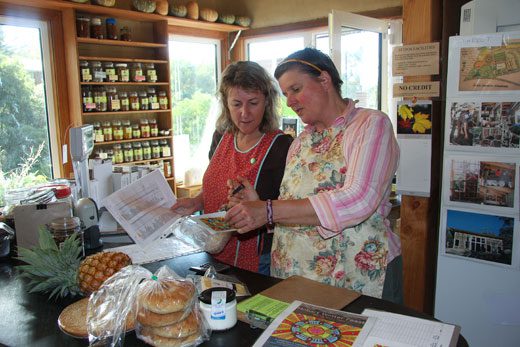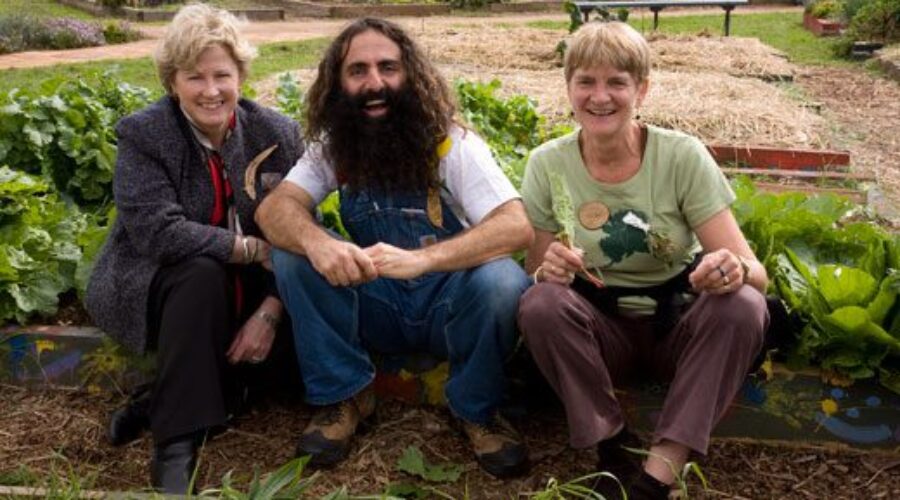2010 Tasmania community gardening conference
Story and photos by Russ Grayson
…good food, innovative people, great place
BY THE DAY BEFORE, THE TASMANIAN COMMUNITY GARDENS NETWORK conference in Devonport – The Good Food Future — had received a total of 90 registrations. A total of around 140 turned up on the first day. Consequently, there was something of a deficit of lunches on opening day, but lunch in the community garden the next day was convivial and all-too-pleasant in the mild Tasmanian autumn weather.

The conference was in Reece High School, just across the road from Devonport Community Garden of which we had a guided tour. The mayor of Devonport opened the conference and said good things. Devonport Council was a conference supporter.
It was good to go back to Devonport after decades of absence. A small city on the Bass Strait coast of northern Tasmania, it is not exactly a bustling metropolis and it retains that lonely air that you find in this part of the island. That comes from a perception of isolation thought it’s only 45 minutes flying time from Melbourne. The perception also stems from the presence of Bass Strait which, for Tasmanians, forms a psychological barrier with the mainland and helps them define themselves as somehow different from those to the north over the grey seas. This forlorn feeling is especially noticeable as you stand on the small beach at the mouth of the Mersey and gaze out into the Strait… grey sea, grey clouds, grey sky, and a feeling of distance from the big landmass to the north.
That the city has a community garden speaks volumes of how the practice of community gardening has grown tremendously and spread far and wide across the continent. It’s quite a nice garden, there are allotments and a range of fruit trees and berry fruit vines — Tasmania produced superb berry fruit of many varieties. There’s a path that connects both ends of the community garden and the public can walk through during opening hours.
For the conference, the theme given to me was food security and I was one of four on a ‘mentors panel’ that started the event by making presentations and engaging in Q&A around the theme.
Others on the mentor’s panel were:
- David Adams, professor of Management in Innovation at the Australian Innovation Research Centre at the University of Tasmania and chair of the Tasmanian Food Security Council (part of the Social Inclusion Unit of the Department of Premier and Cabinet)
Download Food Security Strategy [PDF 1.3MB] - dietician and UTas lecturer, Sandra Murray, who looked at how Tasmania could produce the food types that would supply a balanced diet
- Jennifer Alden, CEO of Cultivating Community in Melbourne.
A Sydney-based telegardener called Costa Geogiadis opened the event and stayed for the two days. Turns out he lives close by us here in Sydney city east and I had a bit if a talk with him although, not having a TV, I have never seen his program. We agreed to catch up in Sydney.
A local politician, Christine Milne (Greens), did a talk and stayed for the whole first day. Ms Milne said that gardening keeps her sane. She has her own gardening website.
Of great interest were the displays at the conference — the local, organic fruit and vegetables and the displays of different organisations.
Community gardening and social inclusion

It was good to met the Social Inclusion commissioner, David Adams, who heads the new Tasmanian Food Security Council. The council will develop a food policy which looks like it will promise support to community gardens as well as social enterprise. Professor Adams seems to understand the problems associated with the grants system and talks of investment instead.
Net Smit, who works with Eat Well Tasmania and who is an Australian City Farms & Community Gardens Network Tasmania contact, has been elected to the Tasmanian Food Security Council.
The good news is there is now a CSA (community supported agriculture) looking to start in the northwest of the state. It’s amazing how the CSA idea has caught the public imagination these past couple of years.
Making fresh even fresher
In Hobart, we were warmly welcomed to a new citizen initiative called The Source.
This is a demonstration/training centre on UTas land in Sandy Bay. It’s on the side of a hill and in the distance, you glimpse the wide Derwent estuary and the low hills of the Eastern Shore beyond. When I lived in this city some decades ago, urbanisation was only then starting its spread along that shore. Now, it’s progressed and, with the expansion towards New Norfolk along the highway beside the river on the northern edge of the city, Hobart is starting to sprawl. It remains a linear city, however, that follows the path of the Derwent and whose westward expansion is blocked by the bulk of Mt Wellington that stands high above the city.
The Source wholefoods setup features a strawbale and recycled timber food co-op building with gardens of vegetables surrounding it. People pick the vegetables they buy, making fresh even fresher.


Over at one end of the site is a new brick oven in which pizzas were in preparation for lunch that mild, mid-Autumn day. Notable in the garden crew working that day was David Stevens, veteran Tasmanian organic gardener. He was working on the compost system and explained that compost was something he likes being associated with. Wherever you find urban food growing in Hobart, you are likely to find David.
While in Launceston at the other end of the state we revisited the extensive allotments of the Punchbowl Community Garden in Punchbowl Reserve, where it marches over dip and hollow colonising the slope for edibles. This is a garden of large allotments, far larger than what passes for allotments in Sydney. These are family-size. If you don’t know where the garden is, you might have to explore a little until you uncover it on the slope above the forested area where families picnic in the lower part of the reserve.
Good people
Tasmania is this sometimes strange place given to throwing up truly innovative people. Bill Mollison comes to mind — yes, on the way back from the icy summit of Mt Wellington with its gale force blasts we drove down Hobart’s Strickland Avenue where all that permaculture stuff began over 30 years ago in Bill’s house. Going down that winding road, I recalled reading in Bills autobiography, Travels In Dreams, how the powerful bushfires of 1967 burned down from the incinerated forests of Mt Wellington into the Avenue. I recalled, too, other notables from this island — the actor of the 1930s, Errol Flynn, and writer Christopher Koch.
Tasmanians, of course, are a creative bunch and it is to Nel Smit and her fellow organisers that thanks go for organising a superb community gardeners’ conference, one that took community gardening further into the realm of food security.
Then there’s the graceful Hannah Maloney from Hobart, dressed in her stylish but earthy clothing, who gave perhaps one of the best introduction to permaculture talk I have heard. And Nick, a doctor active with TransitionTasmania, too… it was good to sit in on the transition team’s meeting.
And then there’s all the others, too — far too many to name even if I could remember all of their names.
The Good Food Future was a good conference truly done good. Thanks Tasmanian community gardening crew!

